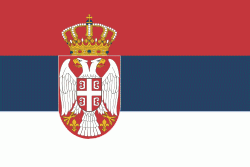Bačko Gradište (Bačko Gradište)
Bačko Gradište (Бачко Градиште, ; Bácsföldvár, ; Feldwar in der Batschau) is a village located in the Bečej municipality, in the South Bačka District of Serbia. It is situated in the Autonomous Province of Vojvodina. The village is ethnically mixed and its population numbering 5,445 people (2002 census). Largest ethnic groups in the village are Hungarians (46.26%) and Serbs (44.39%). Linguistically the village has a Slavophonic plurality as Serbs, Yugoslavs, Croats, Montenegrins and ethnic Muslims collectively compose 49.35% of the population. In early 2007, the village was, among others, affected by the measles outbreak that attracted WHO attention.
Former Serbian name of this village was Feldvarac (Фелдварац). Historical sources from 1316 mentioned several settlements with name Feldvarac, but it is not sure which one of those could be identified with modern village. However, documents show that Serbs lived there before, during and after Ottoman rule.
The oldest and most reliable mention of place is from 1387 when it was part of the feudal lands of the Gorjanski family. In 1440, it belonged to the Serbian despot Đurađ Branković.
In 1519, there were, according to a 1925 article by ethnographer Borivoje Drobnjaković twelve Serbian households. By 1580, the number had decreased to four.
After the Ottoman forces left, Bačko Gradište became part of Tisa military border district. According to Habsburg census from 1720, this village was populated exclusively by Serbs, while in 1910 there were 1,390 houses with 6,922 inhabitants—3,934 Hungarians; 2,890 Serbs; and 98 Jews. In 1921, the population was 7,007 with a Hungarian majority.
Former Serbian name of this village was Feldvarac (Фелдварац). Historical sources from 1316 mentioned several settlements with name Feldvarac, but it is not sure which one of those could be identified with modern village. However, documents show that Serbs lived there before, during and after Ottoman rule.
The oldest and most reliable mention of place is from 1387 when it was part of the feudal lands of the Gorjanski family. In 1440, it belonged to the Serbian despot Đurađ Branković.
In 1519, there were, according to a 1925 article by ethnographer Borivoje Drobnjaković twelve Serbian households. By 1580, the number had decreased to four.
After the Ottoman forces left, Bačko Gradište became part of Tisa military border district. According to Habsburg census from 1720, this village was populated exclusively by Serbs, while in 1910 there were 1,390 houses with 6,922 inhabitants—3,934 Hungarians; 2,890 Serbs; and 98 Jews. In 1921, the population was 7,007 with a Hungarian majority.
Map - Bačko Gradište (Bačko Gradište)
Map
Country - Serbia
 |
 |
| Flag of Serbia | |
Continuously inhabited since the Paleolithic Age, the territory of modern-day Serbia faced Slavic migrations in the 6th century, establishing several regional states in the early Middle Ages at times recognised as tributaries to the Byzantine, Frankish and Hungarian kingdoms. The Serbian Kingdom obtained recognition by the Holy See and Constantinople in 1217, reaching its territorial apex in 1346 as the Serbian Empire. By the mid-16th century, the Ottomans annexed the entirety of modern-day Serbia; their rule was at times interrupted by the Habsburg Empire, which began expanding towards Central Serbia from the end of the 17th century while maintaining a foothold in Vojvodina. In the early 19th century, the Serbian Revolution established the nation-state as the region's first constitutional monarchy, which subsequently expanded its territory. Following casualties in World War I, and the subsequent unification of the former Habsburg crownland of Vojvodina with Serbia, the country co-founded Yugoslavia with other South Slavic nations, which would exist in various political formations until the Yugoslav Wars of the 1990s. During the breakup of Yugoslavia, Serbia formed a union with Montenegro, which was peacefully dissolved in 2006, restoring Serbia's independence as a sovereign state for the first time since 1918. In 2008, representatives of the Assembly of Kosovo unilaterally declared independence, with mixed responses from the international community while Serbia continues to claim it as part of its own sovereign territory.
Currency / Language
| ISO | Currency | Symbol | Significant figures |
|---|---|---|---|
| RSD | Serbian dinar | дин or din. | 2 |
| ISO | Language |
|---|---|
| BS | Bosnian language |
| HU | Hungarian language |
| SR | Serbian language |















